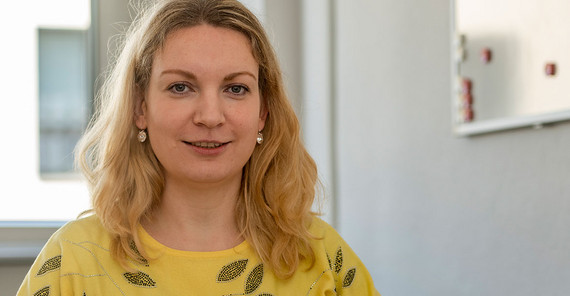The CRC 1287 researches the “Variability of Language”. How variable is language?
Very variable. This is nothing new, we all experience it every day. Anyone who has learned a foreign language can easily relate to this: Not only the vocabulary but also the grammars of the languages differ. An example: In some languages, the adjective usually comes after the noun: when we speak of the red house, it is “la casa roja” in Spanish. But we don’t have to look that far either: Our means of communication differ day by day, depending on what we use them for and who we’re talking to, whether we’re conducting an interview, two teenagers are talking to each other, or we’re writing a newspaper article. Language is variable on many levels.
The main focus of the CRC is on the limits of this variability. Why?
Exactly. We are actually interested in the limits of this variability and the reasons behind them because even though we discover much variability, not everything is possible! That is what we are examining: Why do some logically expectable patterns apparently not exist? The limits are particularly interesting because they tell us something about our cognitive system.
How do you research this?
In different ways. Depending on the aspect of the respective variability. That is why the subprojects in the CRC address so many different questions and apply diverse methods. One possibility is language comparisons. This involves looking at a linguistic phenomenon in various languages to track down cross-linguistic patterns. Which patterns exist (and how often), which do not? Do they correlate with other properties of the languages? Project C08, for example, looks at the subject - verb - object position in a sentence and the question of whether the linear sequence of these elements determines other syntactic (relating to sentence structure) and morphological (relating to the formation of word forms) features of a language.
Do you also examine the changes in language?
Yes, because examining how language changes within a community over time also helps to delineate the limits of linguistic variability. For German, for example, Project C06 investigates how language processing influences syntactic variability. Phase 1 showed that the placement possibilities of infinitive-objects in the sentence - such as “dass Maria ihnen erlaubt hat, den Artikel zu lesen” or “dass Maria ihnen den Artikel zu lesen erlaubt hat” or “dass Maria ihnen den Artikel erlaubt hat zu lesen” - have decreased from Early New High German to contemporary German. The reduction in variation is useful because it avoids ambiguity. In addition, C06 has shown in a series of psycholinguistic experiments that the now rarely produced sequence with split infinitive - such as “dass Maria ihnen den Artikel erlaubt hat zu lesen” - is harder to process than the other two.
What role does language acquisition play for the CRC?
Of course, we are also interested in the acquisition of linguistic structures. Are some of them more difficult to learn than others? In fact, there are various restrictions in this process. Project C07, for example, analyzes how children acquire the sound inventory of their native language - and also awareness of the restrictions on the possible combinations of these sounds. The key question is whether the acquisition process relies solely on experience, i.e., on the concrete language that children hear from their parents, or if the realm of possibilities is also determined by universal tendencies, independent of experience. One such tendency is the sonority hierarchy, which says that at the core of a syllable, a vowel is the most sonorous unit, while sonority “decreases” toward the edges. There are languages that do not permit syllables lacking this structure. Moreover, adults prefer to hear such syllables, what is referred to as a higher acceptability, and they set the syllable boundaries accordingly.
The project is now examining infants growing up bilingually, where one of the languages follows the hierarchy but the other has exceptions. Does the hierarchy nevertheless limit variation in the language acquisition process in these children? And indeed, it seems as if linguistic variations that are contrary to general or widespread principles are unstable. Conversely, this means that there are limits in our language system which ensure that we learn or master certain structures better, easier, faster.
What else are you examining?
A fourth research focus of the CRC are computer models that map or simulate language. These are artificial neural networks that learn linguistic structures with the help of large corpora. Experiments are then conducted to see which structures they can produce. What do they predict as natural, and what not? And how do they deal with variations that do not occur in natural language?
Finally, the CRC also conducted training studies: In Project C01 (Phase 1), for example, speakers were trained to use structures that they normally use rarely or not at all – but that are quite common in other languages or even dialects. The question was: Can structures that exist in natural language – but are not in one’s own use – be acquired more easily than those structures that never occur? It turned out that the test persons can indeed learn these structures but do not actually use them despite a lot of training. An extremely exciting, but also extremely time-consuming approach.
What are you yourself researching in the CRC?
I investigate phenomena that affect sentence structure. I am particularly interested in the conditions under which elements in a sentence can be shifted. In particular, I am analyzing those structures that exhibit unexpected properties and that, on the surface, initially appear to have little variability because they occur in many unrelated languages of the world. In our research, however, we have been able to show that seemingly similar structures can often be formed in different ways. That means that they have a variable derivational history. Following from this, we expanded our research in the second phase of the project: In phase 1, we saw variation everywhere and looked for its limits. Now we are looking, essentially inversely, at structures that on the surface do not appear to be variable at all but, in fact, are. This phenomenon is called “hidden variability”. But here, too, we find limits in the variation of possible underlying structures.
The CRC is now in its second funding period. Five years of research are already behind you. Time for some preliminary conclusions? What kind of assessment can you make at this point?
One might think that variation turns out to be a disruptive factor and that too much variation makes language learning more difficult. But we were already able to show in phase 1 that this is not the case. Variation is not a background noise that makes life difficult for us and that we have to endure. Rather, variation can convey important information. For example, project C03 has explored how children learn to distinguish sounds and link sound sequences to objects – in other words, how they learn words. Different speakers may actually articulate sounds – such as b and p – very differently. Now, you might think that children who are learning to speak would be irritated by this and learn the corresponding words more slowly. But the project shows that the opposite is true! It helps them in learning when they are exposed to different speakers and different situations. And they learn the sounds as well as the links to the objects faster.
What are you going to research in the second phase?
As I said, we are increasingly focusing on “hidden variability”, i.e., linguistic variability in places where there is seemingly none. As a second major topic, we want to test the models we developed based on the results of phase 1 and see if and how they can be used to verify predictions. For example, Project B04 looked at how test subjects process word and sentence structures in their native language in comparison to a learned foreign language. The researchers found large individual differences. The model derived from this will now – based on the performance of speakers in language 1 and 2 – make it possible to predict how they will perform when learning a third language. The project is testing this with native German speakers who, after they learned English, are also learning Turkish with the help of an online platform. Project B02, on the other hand, investigated in phase 1 how people who have “acquired” a language impairment, for example as a result of a stroke, process language. Based on this, we will verify predictions about the language production of these subjects. So, we have a lot to do!
The Researcher
Prof. Dr. Doreen Georgi studied linguistics and Romance studies at the University of Leipzig, where she also received her doctorate. She became Junior Professor at the University of Potsdam in 2016. She has been Professor for the “Variation and Variability in morphosyntactic/morphological systems” since 2020 and spokesperson of the CRC 1287 since 2022.
Mail: doreen.georgiuuni-potsdampde
The Project
The Collaborative Research Center 1287 researches the cognitive, computational, and grammatical aspects of the “Limits of the Variability in Language”. The interdisciplinary CRC 1287 consists of 16 scientific sub-projects and an integrated Research Training Group.
Duration: 2017–2025
Funding: German Research Foundation (DFG)
www.sfb1287.uni-potsdam.de
An example …
Project B01 “(In)Variability in prosodic cues and their incremental use in perception, production, and interaction” examines how and under which conditions younger and elderly individuals use prosody. To do this, the team uses sentences or phrases that contain exactly the same words but have different meanings, depending on how the different parts of the sentence are grouped - in other words, how prosody is used. Depending on the prosody, for example “(Mona and Lili and Nina)” in contrast to “(Mona and Lili) and Nina”. “In the first phase of the CRC (2017-21), we were able to show that our speakers used prosody very consistently,” says Prof. Dr. Isabell Wartenburger, one of the three project leaders, “It was particularly interesting that the use of prosody showed a very individually stable pattern of features.” At the same time, the comparison between the different speakers revealed large differences in the prosodic features they used. This supports theories that assume speakers use prosody automatically and “for themselves” and not actually “for the listener”. “In the current phase, we are now testing in the interactive task whether this is also confirmed in more natural communication,” Prof. Wartenburger says.
This text appears in the university magazine Portal Wissen - Zwei 2023 „Exzellenz“ (PDF).


